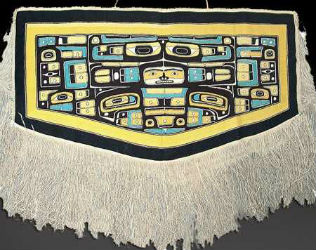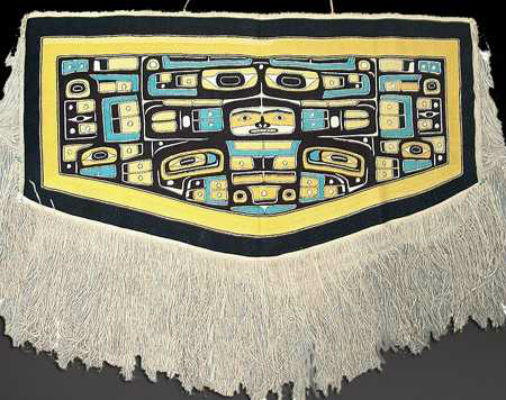
NEW YORK – For the indigenous peoples of the Pacific Northwest Coast, colorful art expressed in stone, wood and weavings tells the story of ancestry and community.
Prior to European contact, the interconnected Pacific Northwest tribes along the coast and inner islands of British Columbia, Washington and Oregon routinely battled each other for salmon and other resources. Yet, these tribal communities also had civil traditions.
The potlatch was a regular ceremony within each of the several dozen distinct communities to tell origin stories and celebrate life events such as births, marriages, coming of age, deaths and leadership transfers, among others. Gifts were given in a keen competition for higher status within a community that enabled families to accumulate wealth. The name itself means “to give away” from a Nuu-chah-nulth word. Many utilitarian items such as baskets, robes and masks were part of the potlatch ceremonies.
After European contact in the late 19th century, the potlatch became illegal in Canada as the idea of a “gift economy” was considered “uncivilized.” Production of traditional utilitarian items became mass produced and intended mainly as trade items with the Europeans. The ban on the potlatch was reversed only in 1951, but production of distinctive tribal items continues mostly as trade with the outside world.
Definable Shapes
It’s easy to recognize traditional Northwest Indian art through its rounded and more curvilinear shapes, particularly as they are used in wood carvings and woven in ceremonial textiles as opposed to other Native American art that features more geometric or linear designs. Several key factors to look for in Pacific Northwest Indian art are:
– Formline, the black outline that identifies the shape of the artwork whether it be animal, bird, or person. Additionally, each of the individual parts will be outlined in black. There is no standard for thickness as each part may be highlighted differently.
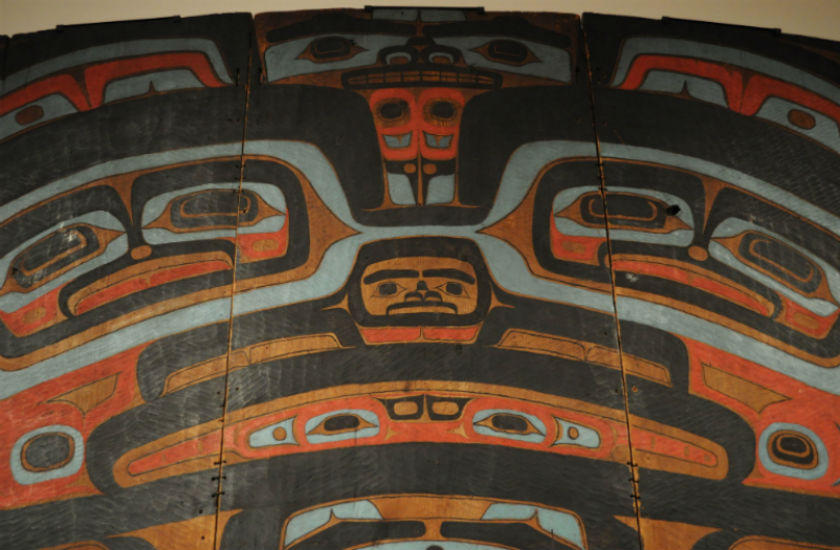
– L shape, a decorative device that can enclose and highlight a space or even act as a filler within the design itself.
– Ovoid, a shape used to highlight eyes, wings, tail feathers and even fins on a fish. Whether large or small, ovoids can also be used to fill unused space or to balance an overall design.
– S shape, multiples of which can form a rib cage, for example, or even suggest arms and legs while also being used to seemingly connect different parts of a design.
– U shape, used mainly to identify tailfeathers, feathers, tongues, claws, flippers, feet, hands, wings and ears. A U shape can vary in proportion depending on the subject. The U shape can also be split in the middle with a lighter color such as white.
Limited Colors Used
The main colors are black, red, yellow, blue-green and white or, perhaps, no color at all with just the use of a varnish over the overall carving.
Black is always used as the first color particularly for the formline. For carvings, the pigment was derived from charcoal, graphite or lignite coal before commercial paint was available. Red was a secondary made from red ochre and hematite minerals, ground and mixed with water. Both were, at first, added to the cedar wood before carving began. Contemporary woodcarvers add color after carving.
Additional colors such as yellow, white and blue to green are additional primary colors used mostly as filler for minor shapes and decorative parts of the overall design.
Objects Most Often Collected
Totem Pole – Usually made of red cedar, as most carvings are, the totem pole, usually about 6 feet tall, tells a complete story about family, ancestors and spirits, and was used to identify a family or clan. They are created as doorways, memorials, internal roof supports and to identify important members of a community.
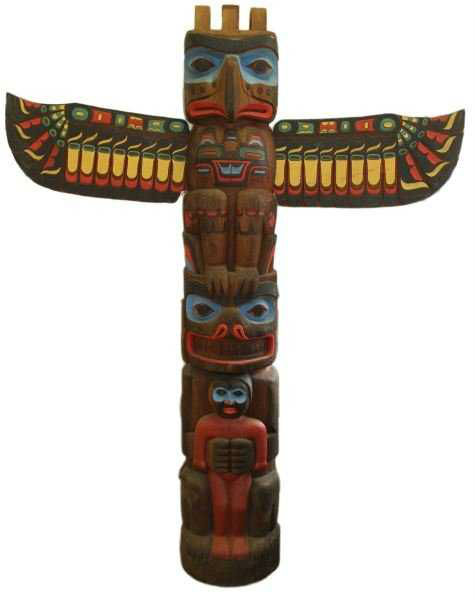
Mask – There are actually three types of masks: a single carved mask, a mechanical mask with parts that move and a transformational mask that consists of an outer mask, an inner mask and possibly even a third mask. Many have real hair, feathers, straw and even skin to project a more lifelike appearance. An important use of the mask is for a potlatch and used to tell stories in a ritual dance.
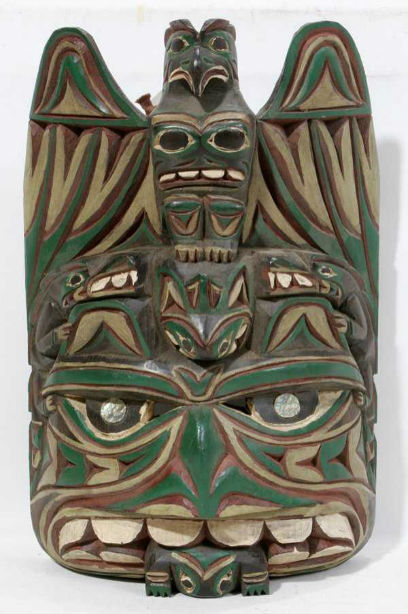
Chilkat blanket – A symbol of authority usually worn for ceremonies, a Chilkat blanket is woven from wool, traditionally goat and cedar bark. Women dyed the wool, then spun it into intricate design patterns on a wooden pattern board frame. A Chilkat blanket, with its intricate design and identifiable long fringe of wool worn over the shoulders, can take nearly a year to complete.
Button blanket – Another ceremonial blanket worn over the shoulder is a button blanket. Like the Chilkat, it is also woven from wool, but features a stylized symbol of the clan appliqued of flannel with red borders along the top and sides surrounded by buttons of abalone, mother of pearl or another type of shell. It is worn over the shoulders by an individual with the symbol resting on the back of the wearer during ceremonies or potlatches.

Argillite carvings – Argillite is a dark gray to black type of slate found on Haida Gwaii, an island off the western coast of Canada originally known as the Queen Charlotte Islands. The carvings are created by the Haida for pipes, household utensils, totem poles and all manner of figurals.
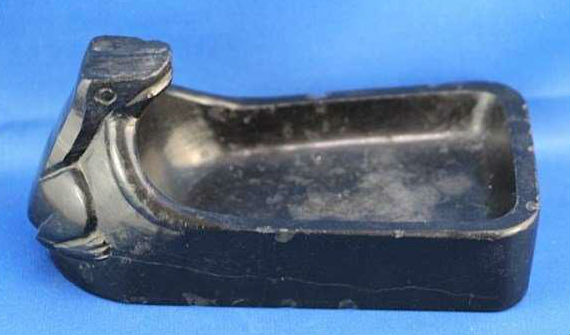
Basket – The Coast Salish communities on the western coast of British Columbia and Washington State figure prominently in weaving baskets of simple abstract design. The technique includes coiling, twining and plaiting using cedar roots with other barks and grasses used as the contrast to create geometric patterns.
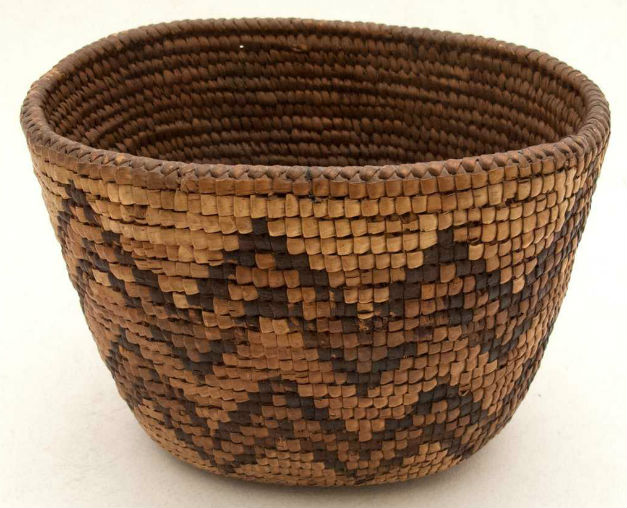
Copper – Ceremonial objects are wider at the top and thinner at the bottom made from copper that is not indigenous to the region and usually painted black. The bottom is divided into a “T” shape to represent the backbone. Early decorations were hand-incised to expose the decoration through the paint so that it can easily be seen by bonfire. More recent copper objects are hand- painted rather than incised. Copper identifies status with the tribe and community. Copper objects circulate at a potlatch and come in various sizes.
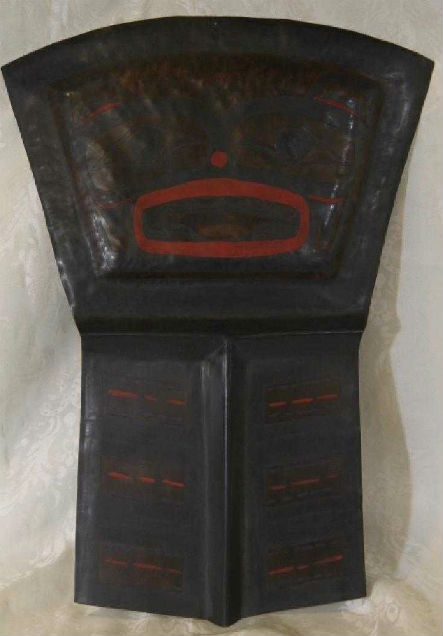
Other Northwest Native Art can include canoes, utensils, paintings, prints, sculpture, clothing and jewelry made from wood, metal and textiles.
The Most Used Representations
The Raven is responsible for bringing the sun into the sky. As the Creator’s assistant, the raven can transform itself into anything. Known as a trickster, the raven can still be considered a symbol of a hero.
Thunderbird is a mythical creature of power, strength and nobility that guards the upper world against the underworld, which is controlled by the Great Horned Serpent. Some consider it to be a special messenger from the Creator. The Thunderbird creates thunder by flapping its wings, which is why it is usually carved with outstretched wings and hunts killer whales for food. The Thunderbird and the killer whales are often carved together.
Sisiutl is a double-headed serpent with a central human-type face used by shaman in Kwakwaka’wakw ceremonies. The legendary creature is attributed with bringing both death and property.
The Bear is the master of the forest and a symbol of power, strength, healing and even friendship. In many rituals, the killing of a bear is treated with honor with dances, songs, stories and prayers.
Eagles are symbols in many cultures, not just in Native American, for its strength, mastery of the skies, and is also a special messenger of the Creator. Feathers represent peace, friendship and a symbol of good luck. Eagle down is usually reserved for the comfort of guests and used in ceremonies. All eagle parts are legally protected religious symbols and only are available to Native American communities.
The killer whale is revered as a hunter and guardian of the seas. In some legends, the killer whales are former fishermen or reincarnations of village chiefs. It is also a fierce source of prey for the Thunderbird. The markings on the killer whale, or orca, may have evolved from wolf family known as pakicetus, according to paleontologists.
Salmon has been a source of food since antiquity for indigenous people of the Pacific Northwest Coast. Legend says that salmon offer themselves as food and once consumed the bones should be returned to the water to spawn into more salmon.
Humans are also used to symbolize ancestry and to tell origin stories of the tribe, clan and community.
Collectibility: How to spot the authentic
Original Pacific Northwest tribal art made from within the tribal communities themselves can be recognized by its use of cedar wood using limited colors, formlines and traditional shapes.
Some notable artists of the 19th century include Charles Edenshaw of Haida Gwaii, who specialized in woodcarving and argillite carvings, and Chief Willie Seaweed of Kwakwaka’wakw, a master carver. Notable 20th century artists include Jim Schoppert of Tlinglit, known for his woodcarving and painting; Freda Diesing a carver of the Haida Sadsugohilanes Clan; and Tony Hunt Sr. of Kwakwaka’wakw, known for his KwaGulth totem poles.
Many items bought at souvenir stands, despite tags that suggest differently, are usually commercially produced plastic or resin-molded versions of traditional tribal art. If exact multiples are present, they are not original. These one-of-a-kind pieces are usually signed by the artist as expressions of traditional tribal history and folklore. For authentic works visit galleries and shops that specialize in Pacific Northwest tribal art.
Resources:
American Museum of Natural History, Chilkat Weaving, exhibition undated
The Evolution of Whales, evolution.berkeley.edu, undated.
The Life Cycle of the Northwest Coast Copper, chaz.org, 2018.
Leung, Clint, An Overview of Pacific Northwest Native Indian Art, meadowbrookfarmpreserve.org, ebook, 2006.
Rudy Reimer, Pierre Freile, Kenneth Fath, and John Clague, “Tales From the River Bank,” Journal of Northwest Anthropology, 2016.
Wikipedia.org, Northwest Coast Art, undated.
Wright, Robin K., Coast Salish Weaving Tools & Technologies, Burkemuseum.org, 2015.


